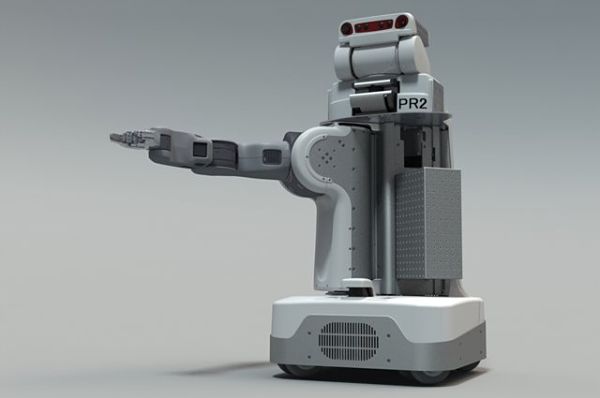I have an idea for a complex robot and I don’t have one
around me as a platform. What can I do? I have two options: to lose
precious time to build one or buy a platform and try to change it. This
is a dilemma which may lose its meaning since PR2 exists.
Willow Garage have developed this platform ready to be modified in terms of software and hardware. The modular system allows for developers to use different grippers, forearms or whole arms. Sensors can be added, changed or removed also.

In terms of software, the platform uses open source projects like ROS, Open CV or Point Cloud Library. ROS is an open source project made by Willow Garage where any enthusiast is free to add new features or modify existing functionality. Open CV gets along very well with ROS and is used for real time computer vision. Point Cloud Library includes a large number of libraries used for mapping and object recognition.These three software platforms control the movement of robot, allow visualization and recognition of objects from the environment and also allow adding new functionality, teaching the robot to do various tasks.
Adding new features can be made virtually at first, to be tested and modified without material costs, after that being added to the physical model. The virtual environment is provided by PR2 simulator, which is another tool to virtually represent a body model of the PR2.
It requires a high processing power to confront the torrent of information from sensors and and fuel decision-making algorithms. The robot’s brain consists of dual Intel Xeon or i7 processors and is assisted by 24 GB of DDR3 RAM memory, 500GB internal memory and a removable HD with a capacity of 1,5 TB.
PR2 is part of Web 3.0. It can be connected to Internet and can be accessed via the Internet. The whole system is powered by a battery pack with capacity of 1,3 kWh for two hours in continuous operation.
Technical specifications reveal a flexible robot with two arms and two grippers that has a maximum payload of 1.8 kg (4 lbs) and 4 N-m (3 lbf-ft) of wrist torque. The force applied in the gripper has a value of 80 N (18 lbf), a value which can ensure proper object gripping or handling objects and even doors can be opened. Velocity and arm position are measured with an accelerometer sensor. Each arm has 8 DOF which are divided as: 4 DOF for arm, 3 DOF for wrist and 1 DOF for gripper. The wheeled platform has a top speed of 1 m/s (3,6 km/h).
The head can move 350 degrees horizontally and 115 degrees vertically. It is an essential component and includes a Kinect sensor, 5-megapixel camera, an environmental wide-angle stereoscopic camera, another camera for the manipulator and a LED texture projector.
At the base there are integrated sensors to allow a safe movement and detect objects around the robot. Hokuyo UTM-30LX is a laser sensor for objects detection with a longer range and fast response. This sensor is ideal to be used in rain, snow, mist and dust conditions as well as in indoor applications. Recognition of surrounding objects would be unnecessary without setting the orientation in space. Microstrain 3DM-GX2 IMU sensor sets the robot orientation.
What can we do with it
PR2 is a platform without limits. Users can make applications for almost any field including engineering, retail, medical, etc. With communities like Stanford, MIT, Berkeley, Georgia, Penn, Tokyo, Munich, Freiburg, etc. we expect a large amount of applications in different industries and services.One of the applications is POOP (a programmed robot to collect poops). It is not easy to make a machine to use in the same time a poop scoop and a container.

Another application comes from Germany, at Technical University of Munich the robot is used to prepare the breakfast and serving it to a group of observers.
Albert-Ludwigs-Universität Freiburg has TidyUpRobot who knows how to clean a table or to recognize the objects and integrate this information in its robot map.
Georgia Institute of Technology comes with Assistive Mobile Manipulation for Older Adults at Home. This robot should help at home with different tasks for older adults.
MIT has developed a with Mobile Manipulation in Human-Centered Environments application. This integration of PR2 should interact with humans in a natural way and recognize objects in order to do simple tasks.
Stanford University invests in STAIR. This project comes with several applications which include taking inventory or clearing a table.
Another interesting application comes from University of Pennsylvania called PR2GRASP. This project io to tracking people in dynamic environments and create possibility to handle objects between robot and humans.






No comments:
Post a Comment